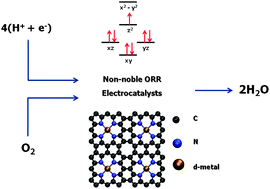Low-temperature fuel cells are appealing alternatives to the conventional internal combustion engines for transportation applications. However, in order for them to be commercially viable, effective, stable and low-cost electrocatalysts are needed for the Oxygen Reduction Reaction (ORR) at the cathode. In this contribution, on the basis of Density Functional Theory (DFT) calculations, we show that graphitic materials with active sites composed of 4 nitrogen atoms and transition metal atoms belonging to groups 7 to 9 in the periodic table are active towards ORR, and also towards Oxygen Evolution Reaction (OER). Spin analyses suggest that the oxidation state of those elements in the active sites should in general be +2. Moreover, our results verify that the adsorption behavior of transition metals is not intrinsic, since it can be severely altered by changes in the local geometry of the active site, the chemical nature of the nearest neighbors, and the oxidation states. Nonetheless, we find that these catalysts trend-wise behave as oxides and that their catalytic activity is limited by exactly the same universal scaling relations.

You have access to this article
 Please wait while we load your content...
Something went wrong. Try again?
Please wait while we load your content...
Something went wrong. Try again?


 Please wait while we load your content...
Please wait while we load your content...